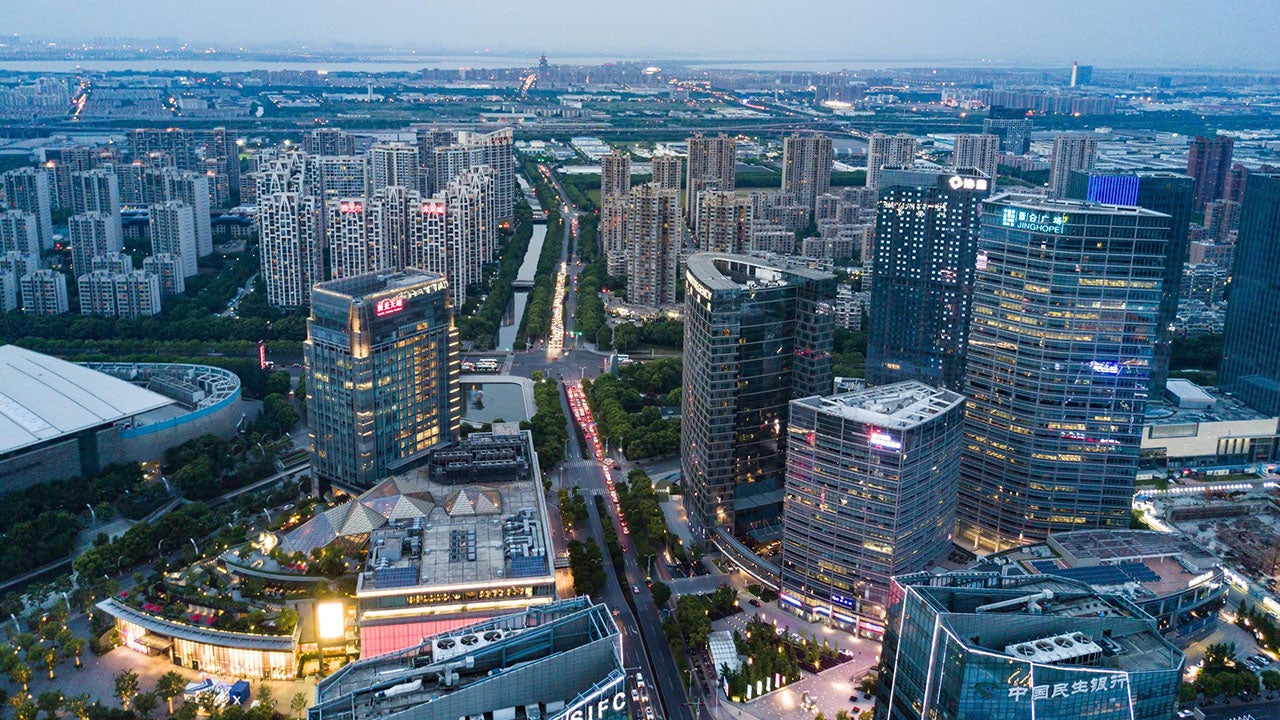The risk of avoiding emerging markets

Putting money into emerging markets can feel like a risky decision.
Emerging markets are perceived as more volatile and politically unstable. Escalating trade tensions between the US and China are fuelling concerns about de-globalisation, a topic addressed in a recent paper by The Economist. China’s economy is weak, leading to worries about consumption and muted demand for commodities. And relatively high US interest rates feed into a stronger US dollar, tightening global liquidity conditions which acts as a headwind for developing economies.
Yet, this narrative is precisely why we believe the risk of not investing in these markets may be greater still. Glass-half-empty perspectives often present good entry points as they don’t capture the full picture.
Legendary stock picker John Templeton famously said that “Bull markets are born on pessimism, they grow on scepticism, they mature on optimism, and they die on euphoria”. This elegantly sums up the investment lifecycle, binding the prospects of future returns to the emotional state of market participants. The pessimism surrounding large segments of emerging markets must be understood in this context.
Challenging conventional wisdom and simple narratives
Firstly, the global economy and trade links are hugely complex, the macro backdrop changeable, and market prices reactive, so it doesn’t generally pay for investors to oversimplify and extrapolate recent trends too far into the future. Over the very long run, different equity markets tend to deliver broadly similar annualised returns with cyclical peaks and troughs. History suggests that market leadership can last for a while, but it does end eventually.
In contrast to the 2000s when emerging market equities outperformed global equities by over 150%, the period since 2010 has seen global equities outperform emerging market equities by 230%, largely driven by US equities.1 The increase in market capitalisation, particularly in US technology stocks, has led to concentration risk for passive investors. The share of US companies in global equity indices now represents over 70% from around 40% two decades ago.2 The weight of emerging market equities has remained stable at around 10%, arguably underrepresenting the potential growth in economic activity from 85% of the world’s population generating 50% of global growth.3
While there is no meaningful correlation between economic growth and market returns, the development of globally competitive EM-based companies trading at compelling valuations deserves attention. Starting valuations have historically been a helpful barometer when thinking about subsequent returns. At present, the MSCI EM Index trades on a forward price-to-earnings (P/E) ratio of 11.7x and a price-to-book (P/B) ratio of 1.7x. Whilst not at historical trough levels, these are at a 34% and 48% discount respectively to the MSCI World Index. Also, treating emerging markets as a monolithic entity overlooks the valuation dispersion across markets and within sectors. Only 20% of Chinese stocks trade at a forward P/E ratio above 20x, whilst 80% of Indian stocks do.4
We like to remind ourselves that what feels comfortable at any given time is rarely profitable. Mr Market doesn’t give away excess returns that easily. When thinking about emerging markets and opportunities within the asset class, we believe that success depends not on eliminating risk entirely but rather on investing where risk is being rewarded, as it is now.
Past performance does not predict future returns.
Where could the market be underappreciating emerging market equities?
- De-globalisation is overstated, and EM resilience understated
Globalisation’s obituary has been written several times with the IMF and WTO recently warning that international trade is fragmenting along geopolitical lines. So far, this fragmentation has been insignificant representing around 2% of global trade according to estimates, largely caused by Russian sanctions.5 This figure is also likely to be overstated because trade is being re-routed through connector countries to avoid sanctions; under-counted to avoid tariffs on China; and supply chains of goods have aptly shifted the final assembly stage to ‘friendly’ blocs before being imported.
Of course, fragmentation could get worse, but for Asia, Latin America, the Middle East, and other developing countries – home to 6.7 billion people – the idea that intra-regional trade cannot flourish is doubtful. Corporations will continue to find ways to trade, with business flowing either where it is the most profitable, or alternatively, if walls and barriers are put up, around these walls to find new destinations. Annual intra-EM trade represented around $4.5tn by end 2023, an 80% increase since 2016 when US tariffs on Chinese goods were introduced.6
Emerging markets offer diversification benefits due to their diverse and varied nature. Some countries such as India and Indonesia have compelling growth attributes from rising incomes, urbanisation and positive demographic trends creating a growing cohort of middle-class consumers. Equally promising are emerging economies endowed with abundant natural resources, such as those in Latin America, given the vital role they play in the renewable energy transition. Commodity prices and related investments have been lacklustre over the past few years subsequent to the spike in 2022. However, long-term demand combined with a general reluctance to add new capacity is a potent combination, potentially sowing the seeds for the next capital cycle which is why we have some exposure to copper assets. Meanwhile, the economies of Emerging Europe and Mexico are enjoying market share gains in manufacturing, as a shift towards more decentralised and resilient global supply chains takes place, benefiting countries with cheap and abundant labour near the end consumers of Europe and America. Rather than de-globalising, the diverse group of emerging countries are re-globalising.
Given its size China may be treated as a separate asset class, which is why we now also offer an Emerging Markets ex China Equity strategy. China remains a gravitational pull for the wider region, providing industrial know-how, investment, technology transfer, and trade opportunities. While most of China’s capacity is deployed domestically, there are concerns of overcapacity in electric vehicles, batteries, solar panels, and mature-node semiconductors. China’s ability to export this to the US and Europe will be limited as barriers are put up to uphold national security imperatives and employment. However, the availability and affordability of essential clean technologies should see a market in other emerging countries looking to industrialise and decarbonise. Chinese EV manufacturers, for example, have around 90% market share of EVs in Brazil, and 70% in Thailand.6
How resilient are emerging markets? Putting aside the fundamental merits, the recent global market spike in volatility was informative. The weak US jobs data in August 2024 led to concerns of rising US recession risk, combined with a jump in the Japanese yen which triggered a carry trade unwind. This type of event would normally be enough for global investors to dump ‘risk assets’ as they did during the ‘taper tantrum’ in 2013. Instead, emerging markets assets were relatively resilient and uncorrelated. While high-yielding EM currencies like the Mexican peso and Brazilian real sold-off, as they were on the other side of the yen carry trade, the lower yielding currencies in Asia appreciated. Also, perhaps surprisingly, high yielding currencies such as the Indonesian rupiah were left unscathed. With the economic growth gap turning favourable for EM and no obvious signs of overheating or currencies being overvalued, EM assets should be more resilient to shocks. Indeed, undervalued and under-owned assets do not tend to suffer from the unwinding of crowded trades. This is another reason for global investors to give EM assets another look.
- A valuation discount set against a compelling earnings and dividend profile
A dollar of earnings from emerging market companies currently trades at a 45%discount to that of companies in the S&P 500.7 This is partly a reflection of the past. Aggregate earnings-per-share (EPS) growth from American companies over the past decade have been far superior, supported by a strong US dollar, tax cuts, and very low interest rates by historical standards. It also reflects the monopoly-like successes of a narrow sub-set of US companies reaching record levels of market cap. Looking ahead, the earnings growth outlook and fundamental profile of emerging markets should not warrant such a valuation discount.
Earnings-per-share (EPS) growth for EM equities over the next three years is expected to be around 15% annualised, slightly above expectations for the S&P 500.8 Also, the balance sheets of corporates in emerging markets are healthy, reflecting their preference for net cash buffers over elevated leverage. This conservatism has the advantage of providing greater optionality and an ability to increase payouts. Some emerging markets are increasingly adopting strategies like share buybacks to boost shareholder returns, a practice that has been more prevalent in the US historically. Indeed, shareholder return yields – measured as dividends-plus-buybacks divided by the market cap – are increasingly attractive in our investment universe. We observe tangible improvements in Korea and China in particular, a topic we discussed in detail in our 2Q24 quarterly report. Furthermore, the market is increasingly valuing high and rising shareholder yields with higher valuation multiples. This reflects the potential for enhanced ROE as cash is deployed and signals that shareholders’ interests are being prioritized.
We rely on stock picking, not concentrated bets
Our strength as an investment team lies in our stock-picking expertise within emerging markets rather than making broad macro or asset allocation calls. Our edge lies in an understanding of investor psychology and contrarian thinking. We prefer to build diversified portfolios that are resilient to unexpected scenarios and avoid making large, concentrated bets. Instead, we care about the price we pay for the value we get and like strong balance sheets, viewing periods of market fear and volatility as an invitation to unearth overlooked companies.
Investment risks
The value of investments and any income will fluctuate (this may partly be the result of exchange rate fluctuations) and investors may not get back the full amount invested.




